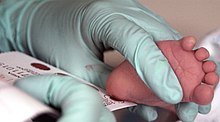Dried blood spot
The analysis of dried blood drops, English Dried blood spot tests (DBS), is a measurement method based on sampling, in which blood drops are dried on filter paper. The dried samples can be sent to an analytical laboratory without any further effort and analyzed using various methods such as DNA amplification or LC / MS .
history
The method of using capillary blood , which was obtained from a prick in the heel or the finger, for a large-scale newborn screening for metabolic diseases was developed by Robert Guthrie in 1963 ( Guthrie test ) . Newborn screenings for phenylketonuria were introduced around 1970. Since then, Guthrie cards have been routinely collected from children in over 20 countries to test for phenylketonuria and, later, hypothyroidism , sickle cell anemia, and HIV . The limitations in terms of sensitivity and specificity when screening from the small sample volume limited the use of Dried Blood Spot tests for many years. However, modern methods such as the production of monoclonal antibodies , synthetic proteins and PCR have solved these problems.
There are now blood tests for vitamin D , estrogen , testosterone , cortisol , TSH and fatty acids . The method is also used for therapeutic drug monitoring and toxicological issues.
Analysis process
Dried blood samples are obtained by taking a few drops of blood by pricking the finger, heel or toe with a lancet and applying them to special, absorbent filter paper. The blood is drawn into the paper and air-dried for several hours. The samples are kept in airtight plastic bags with desiccant to reduce humidity and can also be stored and transported in tropical climates at ambient temperature.
In the laboratory, a small disc is punched out of the saturated paper with an automatic or manual punch. The punched material is z. B. transferred to a microtiter plate and eluted in phosphate buffered saline solution containing 0.05% Tween 80 and 0.005% sodium azide , overnight at 4 ° C. The plate that then contains the eluates forms the “master” from which dilutions for further tests are made.
As an alternative to punching out a paper disk, newer automation solutions extract the sample by flushing an eluent through the filter without punching it out. Automation including the use of an internal standard prior to extraction was developed by the Swiss company CAMAG.
Dried blood spot tests for HIV infection
The method is considered to have a high potential for the diagnosis of HIV-infected infants in resource-poor environments, since the samples can be stored for a long time, require less refrigeration and the sampling is less invasive than other methods. Unlike ELISA tests for HIV antibodies in the blood, which can be transmitted to infants during pregnancy regardless of the virus itself, the dry blood test can be used to detect genetic material from the actual virus, reducing the chance of a false positive becomes. Tests for HIV are not considered sensitive enough as a diagnostic tool, but they can be useful in assessing HIV prevalence. DBS samples also pose a lower risk of infection for users and are easier to transport and store than liquid blood samples.
Basics
The reason for the stability of DNA , RNA or proteins is probably due to the fact that the biological material binds to the matrix of the filter paper and the drying process removes water, which is an important factor for the effectiveness of proteases or nucleases . In addition, inhibitors are bound that can interfere with various nucleic acid amplification processes.
Individual evidence
- ^ SP Parker, WD Cubitt: The use of the dried blood spot sample in epidemiological studies. In: Journal of Clinical Pathology . tape 52 , no. 9 , September 1, 1999, p. 633-639 , doi : 10.1136 / jcp.52.9.633 , PMID 10655983 .
- ↑ Nonnenmacher: dry blood test. In: symptomat.de. January 6, 2018, accessed January 20, 2018 .
- ↑ Christophe P. Stove, Ann-Sofie ME Ingels, Pieter MM De Kesel, Willy E. Lambert: Dried blood spots in toxicology: from the cradle to the grave? In: Critical Reviews in Toxicology . tape 42 , no. 3 , February 21, 2012, p. 230-243 ( biblio.ugent.be [PDF]).
- ^ Shipping Guidelines for Dried-Blood Spot Specimens. (PDF) In: cdc.gov. Centers for Disease Control and Prevention, October 24, 2017, accessed January 20, 2018 .
- ↑ Guido Deussing, Ilka Ottleben: Determine blood parameters with third blood spot analysis. In: Laborpraxis. Vogel Business Media GmbH & Co.KG, November 4, 2015, accessed on January 20, 2018 .
- ↑ Norbert Ganz, Maharajah Singrasa, Laurent Nicolas, Marcelo Gutierrez, Jasper Dingemanse: Development and validation of a fully automated online human dried blood spot analysis of bosentan and its metabolites using the Sample Card And Prep DBS System . In: Journal of Chromatography B . tape 885–886 , February 15, 2012, pp. 50-60 , doi : 10.1016 / j.jchromb.2011.12.012 .
- ↑ Using a Book-Type Dried Plasma Spot Card for Automated Flow-Through Elution. In: sparkholland.com. Spark Holand, December 20, 2016, accessed January 20, 2018 .
- ↑ What is Dried Blood Spot Sampling? In: camag.com. Camag, accessed January 20, 2018 .
- ^ S. Cassol, T. Salas, MJ Gill, M. Montpetit, J. Rudnik: Stability of dried blood spot specimens for detection of human immunodeficiency virus DNA by polymerase chain reaction . In: Journal of Clinical Microbiology . tape 30 , no. 12 , December 30, 1992, ISSN 0095-1137 , pp. 3039-3042 , PMID 1452682 .
